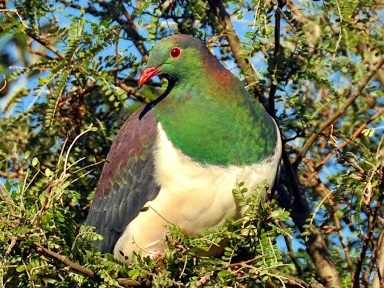Native Ecosystem Biodiversity

25/01/2025 - Please be aware that this page is currently a work-in-progress. Full functionality expected by mid 2025.
Extract from Backyard Biodiversity in Canterbury by Al Check & Mike Bowie
Populations of plants, animals, insects and birds that interact together are known as communities. These communities, along with the physical environment in which they live are known as ecosystems e.g., rivers, forests, tussock lands, wetlands and even suburban backyards.
The greater the diversity of an ecological system the better its chances of being resilient to impacts such as climate change or invasion by pests. It is the native and endemic species of a region that are most significant. However, it is important to make the distinction between species richness (number of species) and biodiversity (each nation’s unique contribution to the world’s genetic, species and ecosystem variation). Introducing foreign species to New Zealand does not increase biodiversity; indeed biodiversity (New Zealand’s contribution to it) is generally diminished by competition, predation and grazing by introduced species causing contraction of indigenous species’ ranges and genetic diversity, and even extinction.
Native Plants
Attracting native birds, bees, lizards and insects means planting natives that provide year round food source, safe breeding sites and protection from predators.
Food Source Key: F = Fruit, S = Seed, N = Nectar, P = Pollen, I = Insects, O = Other
('Other' includes, but not limited to: Bark, Flower Buds, Foliage, Lizards, Tree Sap, Honeydew)
Native Birds (Food Calendar)
Native birds that you are likely to attract to your garden prefer to eat nectar, fruit, seed and insects. Common species and their preferred food are:
| Species (info from NZ Birds Online) | Fruit | Seed | Nectar | Pollen | Insects | Other |
| Kaka (bush parrot) | ✓ | ✓ | ✓ | ✓ | ||
| Kea (mountain parrot) - [Plant Food Sources] | ✓ | ✓ | ✓ | ✓ | ||
| Kereru (wood pigeon) - Diet | ✓ | ✓ | ✓ | |||
| Korimako (bellbird) | ✓ | ✓ | ✓ | |||
| Kotare (sacred kingfisher) | ✓ | ✓ | ||||
| Ngutuparore (wrybill) | ✓ | |||||
| Pipiwharauroa (shining cuckoo) | ✓ | |||||
| Piropiro (tomtit) | ✓ | ✓ | ||||
| Piwakawaka (fantail) | ✓ | |||||
| Riroriro (grey warbler) | ✓ | |||||
| Ruru (morepork) | ✓ | ✓ | ||||
| Tauhou (silvereye or waxeye) | ✓ | ✓ | ✓ | |||
| Tui | ✓ | ✓ | ✓ | |||
| Tuturiwhatu (dotterel) | ✓ |
Bees
Bees feed on and require both nectar and pollen. The nectar is for energy and the pollen provides protein and other nutrients. Most pollen is used by bees as larvae food, but bees also transfer it from plant-to-plant, providing the pollination services needed by plants and nature as a whole.
| Species (info from For the Love of Bees) | Fruit | Seed | Nectar | Pollen | Insects | Other |
| Ngaro Huruhuru - Native | ✓ | ✓ | ||||
| Leioproctus fulvescens - Native | ✓ | ✓ | ||||
| Lasioglossum sordidum - Native | ✓ | ✓ | ||||
| Bumblebee - Europe | ✓ | ✓ | ✓ | |||
| Honeybee - Europe | ✓ | ✓ | ||||
Insects
Most insects subsist on a diet consisting primarily of plants and fruits. Many species of bugs such as butterflies, moths and beetles are herbivorous while others may prefer sweet nectar or sugary sap. Some bugs will even feed off other insects such as aphids or caterpillars.
| Pollinator Species (info from Landcare Research) | Fruit | Seed | Nectar | Pollen | Insects | Other |
| Copper Butterfly | ✓ | |||||
| Red Admiral Butterfly | ✓ | |||||
| Monarch Butterfly | ✓ | |||||
| Drone Fly | ✓ | |||||
| Hover Fly | ✓ | |||||
| March Fly | ✓ |
Lizards
There are more than 90 species found in New Zealand. All except one species are endemic (found only in NZ). If you can catch them eating, you might see them eating insects like moths and flies, which are their main food. But they also enjoy the berries and nectar of some plants and flowers.
| Species (info from NZ Herpetological Society) | Fruit | Seed | Nectar | Pollen | Insects | Other |
| Waitaha Gecko | ✓ | ✓ | ✓ | |||
| Jewelled Gecko | ✓ | ✓ | ||||
| McCann's Skink | ✓ | |||||
| Southern Alps Gecko | ✓ | ✓ | ✓ | |||
| Common Skink | ✓ | ✓ | ||||

Hours
Open 7 days a week: 10am-4pm